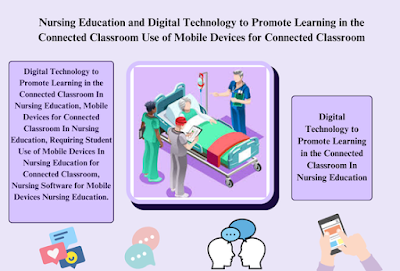The Digital Technology to Promote Learning in the Connected Classroom Use of Mobile Devices for Connected Classroom In Nursing Education. Mobile Devices for Connected Classroom In Nursing Education In today’s digital age, nursing education is being transformed by a variety of technologies that enhance learning experiences. Mobile devices, digital software, and health-related applications play a crucial role in the connected classroom, making education more interactive and accessible.
The Digital Technology to Promote Learning in the Connected Classroom Use of Mobile Devices for Connected Classroom In Nursing Education
Digital learning technologies are increasingly used in nursing education to facilitate a connected classroom environment. Key technologies include:
- Mobile Devices: Computers, smartphones, and tablets provide direct access to online resources and educational apps.
- Presentation Software: Tools for creating and sharing multimedia presentations.
- Audience Response Systems (ARS): Interactive systems for real-time feedback and engagement.
- E-books and Podcasts: Digital formats for textbooks and supplementary audio learning materials.
- Wikis: Collaborative platforms for sharing knowledge and resources.
To maximize the benefits of these technologies, educators must use them purposefully, integrating them into the curriculum rather than using them for novelty.
Mobile Devices for the Connected Classroom in Nursing Education
Mobile devices—such as laptops, smartphones, and tablets—are essential for modern nursing education. They offer several advantages:
- Connectivity: These devices provide internet access and support for various applications, facilitating communication with instructors and peers.
- Portability: Mobile devices are easily carried, allowing students to access resources and tools on-the-go.
- Versatility: Smartphones and tablets can be used for various functions, including accessing digital textbooks, managing schedules, and conducting research.
Types of Mobile Devices
- Smartphones: These devices combine internet connectivity with telephone capabilities and support a range of applications. Modern smartphones, often referred to as “phablets,” have larger screens and additional features like cameras and GPS.
- Tablets: Offering a larger screen than smartphones, tablets are ideal for reading and interactive learning. They come with built-in Wi-Fi and some offer cellular connectivity, though this requires a monthly fee.
Requiring Student Use of Mobile Devices in Nursing Education
Some nursing programs mandate that students own mobile devices. This decision involves several factors:
- Evaluation: Faculty need to assess the available options, including hardware costs, software compatibility, and how the devices will be integrated into coursework and clinical practice.
- Student and Faculty Considerations: Issues such as the cost of devices, faculty and student familiarity with technology, and the need for training must be addressed.
- Training and Support: Proper training for both faculty and students is crucial to effectively use these devices. Research suggests that while students appreciate tablets for note-taking and managing schedules, reading textbooks on these devices can be challenging.
Nursing Software for Mobile Devices in Education
The availability of nursing software for mobile devices has grown, offering various tools and references:
- Software Installation: Since smartphones and tablets lack optical disk drives, all software must be installed wirelessly. For Apple devices, apps can be managed through iTunes, while Android apps are available through Google Play and other online stores.
- Cost: Many applications are free or low-cost, with some offering additional features through in-app purchases. Reference titles often require a “bookshelf” app for management and installation.
- Popular Apps: Apps like Skyscape Reader and Unbound Medicine’s Nursing Central offer valuable resources and tools for nursing students. Some providers, like Pepid, offer subscription-based bundles that include multiple reference titles.
Incorporating digital technology into nursing education not only enhances learning but also prepares students for the evolving healthcare environment. By effectively utilizing mobile devices and educational software, nursing programs can create a more interactive and engaging learning experience.
Read More:
https://nurseseducator.com/didactic-and-dialectic-teaching-rationale-for-team-based-learning/
https://nurseseducator.com/high-fidelity-simulation-use-in-nursing-education/
First NCLEX Exam Center In Pakistan From Lahore (Mall of Lahore) to the Global Nursing
Categories of Journals: W, X, Y and Z Category Journal In Nursing Education
AI in Healthcare Content Creation: A Double-Edged Sword and Scary
Social Links:
https://www.facebook.com/nurseseducator/
https://www.instagram.com/nurseseducator/
https://www.pinterest.com/NursesEducator/
https://www.linkedin.com/in/nurseseducator/
https://www.researchgate.net/profile/Afza-Lal-Din
https://scholar.google.com/citations?hl=en&user=F0XY9vQAAAAJ
